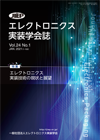Volume 24, Issue 6
Displaying 1-33 of 33 articles from this issue
- |<
- <
- 1
- >
- >|
Preface
-
Article type: Preface
2021Volume 24Issue 6 Pages P6
Published: September 01, 2021
Released on J-STAGE: September 01, 2021
Download PDF (253K)
Special Articles / Education on Electronics Packaging
-
Article type: Special Articles
2021Volume 24Issue 6 Pages 483
Published: September 01, 2021
Released on J-STAGE: September 01, 2021
Download PDF (273K) -
Article type: Special Articles
2021Volume 24Issue 6 Pages 484-487
Published: September 01, 2021
Released on J-STAGE: September 01, 2021
Download PDF (818K) -
Article type: Special Articles
2021Volume 24Issue 6 Pages 488-491
Published: September 01, 2021
Released on J-STAGE: September 01, 2021
Download PDF (1083K) -
Article type: Special Articles
2021Volume 24Issue 6 Pages 492-499
Published: September 01, 2021
Released on J-STAGE: September 01, 2021
Download PDF (2942K) -
Article type: Special Articles
2021Volume 24Issue 6 Pages 500-502
Published: September 01, 2021
Released on J-STAGE: September 01, 2021
Download PDF (641K) -
Article type: Special Articles
2021Volume 24Issue 6 Pages 503-506
Published: September 01, 2021
Released on J-STAGE: September 01, 2021
Download PDF (1076K) -
Article type: Special Articles
2021Volume 24Issue 6 Pages 507-511
Published: September 01, 2021
Released on J-STAGE: September 01, 2021
Download PDF (676K) -
Article type: Special Articles
2021Volume 24Issue 6 Pages 512-514
Published: September 01, 2021
Released on J-STAGE: September 01, 2021
Download PDF (651K) -
Article type: Special Articles
2021Volume 24Issue 6 Pages 515-519
Published: September 01, 2021
Released on J-STAGE: September 01, 2021
Download PDF (928K) -
Article type: Special Articles
2021Volume 24Issue 6 Pages 520-527
Published: September 01, 2021
Released on J-STAGE: September 01, 2021
Download PDF (3242K) -
Article type: Special Articles
2021Volume 24Issue 6 Pages 528-530
Published: September 01, 2021
Released on J-STAGE: September 01, 2021
Download PDF (477K) -
Article type: Special Articles
2021Volume 24Issue 6 Pages 531-535
Published: September 01, 2021
Released on J-STAGE: September 01, 2021
Download PDF (643K)
2020 JIEP Award-Technical Development
-
Article type: Special Articles
2021Volume 24Issue 6 Pages 536-540
Published: September 01, 2021
Released on J-STAGE: September 01, 2021
Download PDF (1283K)
Technical Paper
-
Article type: Technical Paper
2021Volume 24Issue 6 Pages 541-550
Published: September 01, 2021
Released on J-STAGE: September 01, 2021
Advance online publication: April 30, 2021Download PDF (1844K) -
Article type: Technical Paper
2021Volume 24Issue 6 Pages 551-559
Published: September 01, 2021
Released on J-STAGE: September 01, 2021
Advance online publication: June 09, 2021Download PDF (1161K) -
Article type: Technical Paper
2021Volume 24Issue 6 Pages 560-571
Published: September 01, 2021
Released on J-STAGE: September 01, 2021
Advance online publication: July 14, 2021Download PDF (1446K) -
Article type: Technical Paper
2021Volume 24Issue 6 Pages 572-579
Published: September 01, 2021
Released on J-STAGE: September 01, 2021
Advance online publication: July 14, 2021Download PDF (2192K) -
Article type: Technical Paper
2021Volume 24Issue 6 Pages 580-585
Published: September 01, 2021
Released on J-STAGE: September 01, 2021
Advance online publication: July 14, 2021Download PDF (1316K) -
Article type: Technical Paper
2021Volume 24Issue 6 Pages 586-594
Published: September 01, 2021
Released on J-STAGE: September 01, 2021
Advance online publication: August 25, 2021Download PDF (1817K) -
Article type: Technical Paper
2021Volume 24Issue 6 Pages 595-605
Published: September 01, 2021
Released on J-STAGE: September 01, 2021
Advance online publication: August 25, 2021Download PDF (1935K) -
Article type: Technical Paper
2021Volume 24Issue 6 Pages 606-613
Published: September 01, 2021
Released on J-STAGE: September 01, 2021
Advance online publication: August 25, 2021Download PDF (1402K)
Tutorial Series-Next Generation Packaging Technology of Power Electronic Devices Course / (3)
-
Article type: Tutorial Series
2021Volume 24Issue 6 Pages 614-618
Published: September 01, 2021
Released on J-STAGE: September 01, 2021
Download PDF (1112K)
Report
-
Article type: Report
2021Volume 24Issue 6 Pages 619
Published: September 01, 2021
Released on J-STAGE: September 01, 2021
Download PDF (359K)
2021 JIEP Award
-
Article type: Announcement
2021Volume 24Issue 6 Pages 621-630
Published: September 01, 2021
Released on J-STAGE: September 01, 2021
Download PDF (1127K)
Announcement, Contents, etc.
-
Article type: Announcement
2021Volume 24Issue 6 Pages 620
Published: September 01, 2021
Released on J-STAGE: September 01, 2021
Download PDF (267K) -
Article type: Announcement
2021Volume 24Issue 6 Pages 631-633
Published: September 01, 2021
Released on J-STAGE: September 01, 2021
Download PDF (656K) -
Article type: Announcement
2021Volume 24Issue 6 Pages 634-639
Published: September 01, 2021
Released on J-STAGE: September 01, 2021
Download PDF (497K) -
Article type: Special Articles
2021Volume 24Issue 6 Pages 641-642
Published: September 01, 2021
Released on J-STAGE: September 01, 2021
Download PDF (382K) -
Article type: Announcement
2021Volume 24Issue 6 Pages A61-
Published: September 01, 2021
Released on J-STAGE: September 01, 2021
Download PDF (192K) -
Article type: Announcement
2021Volume 24Issue 6 Pages C61
Published: September 01, 2021
Released on J-STAGE: September 01, 2021
Download PDF (265K) -
Article type: Announcement
2021Volume 24Issue 6 Pages C62
Published: September 01, 2021
Released on J-STAGE: September 01, 2021
Download PDF (177K) -
Article type: Announcement
2021Volume 24Issue 6 Pages I61-
Published: September 01, 2021
Released on J-STAGE: September 01, 2021
Download PDF (511K)
- |<
- <
- 1
- >
- >|
